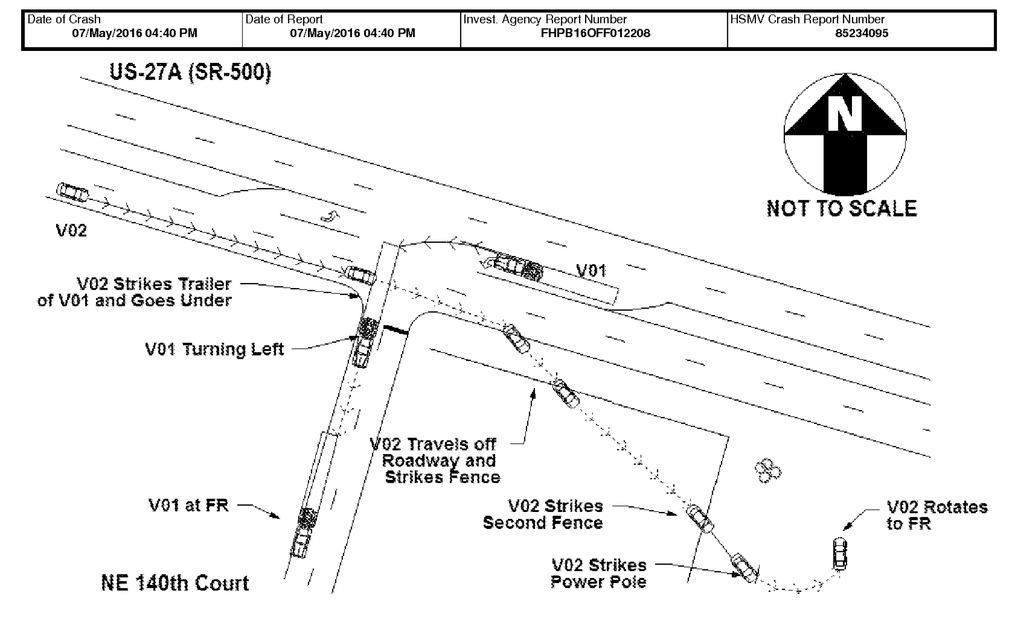
Safety is a key topic for self-driving vehicles. 94% of U.S. crashes involve human error [1]. 37,461 deaths in the road accident in the U.S. in 2016 [2]. People believe self-driving car technology can help reduce the road accidents and save millions of lives per year worldwide. However, self-driving technology is still in developing phase. It has limitation and could not be as perfect as people wish.
- 2016-5-7 Tesla, a 2015 Model S collided with a tractor trailer in Florida, resulting in fatal injuries to the Tesla driver. [3]
- 2018-3-18 Uber, an autonomous test car killed a woman in the street in Arizona at night. [4]
Tesla Case
The victim in Tesla case may be the first person as a driver in human history who lost his life on a “self-driving” car. The Model S was being operated in Autopilot mode at the time of the collision. A tractor trailer turned left on the road in front of the Model S. The driver and the autopilot system failed to take any action. The Model S hit the trailer and traveled under it. It veered off road and stroked two fences and a power pole before it stopped.

NHTSA investigation report shows that they didn’t identify any defects in design in Model S Autopilot system. Driver needs to pay continual and full attention of the driver as the Autopilot system is operated. However, the last recorded driver action was increasing the cruise control set speed to 74 miles less than 2 minutes before the collision. It was a clear day with dry road conditions when the collision happened. The driver didn’t take braking, steering or other actions to avoid the collision.
”Always Keep Your Hands on the Wheel”
Tesla introduced Autopilot system in October 2015 and made continuous updates of the system via OTA updates. The major subsystems in Tesla Autopilot mode are Traffic-Aware Cruise Control (TACC) and Autosteer. Tesla Autopilot system is a Level 2 system when both TACC and Autosteer are activated. Autopilot can maintain the speed and steer under certain conditions, such as highway and freeway. But in a Level 2 system, the driver must still monitor the driving condition and take over immediately when the condition exceeds the system’s limitation. Tesla Autopilot system has provided its system limitation information in multiple ways, including the owner’s manual, a dialog box of reminding Autosteer and etc. According to Tesla’s data, it shows the crash rates in the subject Tesla vehicles (Model S and Model X) before and after Autosteer installation. There is almost 40% dropped after Autosteer installation.

But Tesla Autopilot system is hyped up far beyond its capability. It’s not a hands-free system.
Uber Case
Uber case is the first self-driving car killed a pedestrian on a public road. Uber’s test vehicle was a modified 2017 Volvo XC90. Although there was a vehicle operator inside, it was operated by a self-driving system as the collision happened. The victim walked a bicycle across Mill Avenue. The Uber test vehicle was traveling in the right lane until it struck the pedestrian.

Uber test vehicle equipped with a developmental self-driving system. It included cameras, radars, LIDAR, and navigation sensors. The self-driving system observed the pedestrian about 6 seconds before impact. Pedestrian and his bicycle was classified as an unknown object and then as a bicycle later. Almost 1.3 seconds before the collision, the self-driving system remind an emergency braking maneuver. But it was too late. The vehicle hit the pedestrian in 39mph, and then operator began braking after the impact
According to Uber, emergency braking maneuver was not enabled when the vehicle is controlled by the self-driving system. And the system is not well designed to warn the operator. Although this case is still under investigation, Uber has a critical responsibility to enhance its self-driving system. After this accident, Uber stopped all test vehicles worldwide.
Safety Design Element
In Sep 2017, the U.S. Department of Transportation and National Highway Traffic Safety Administration submitted “Automated Driving Systems: A Vision for Safety 2.0” and offered a non-regulatory approach to automated vehicle technology safety [5]. They listed 12 safety design elements for automated driving systems.
1. System Safety
2. Operational Design Domain
3. Object and Event Detection and Response (OEDR)
4. Fallback (Minimal risk Condition)
5. Validation Methods
6. Human Machine Interface(HMI)
7. Vehicle Cybersecurity
8. Crashworthiness
9. Post-Crash ADS Behavior
10. Data Recording
11. Consumer Education Training
12. Federal, State, and Local Laws
Tesla Model S and Model X with Autopilot system are available in the market. A good education and training of self-driving operation and HMI function program could help the user obtain the necessary level of understanding to utilize these technologies properly.
Uber self-driving system identifies the pedestrian and didn’t give any response. However, an automated driving system should be responsible for performing OEDR while it is operating in its defined operational design domain.
As more self-driving cars are available in the market, the safety of self-driving car will receive more and more attention.
[1] Critical Reasons for Crashes Investigated in the National Motor Vehicle Crash Causation Survey
[2] 2016 Fatal Motor Vehicle Crashes: Overview
[3] Tesla Accident investigation report
[4] Uber test vehicle preliminary report
[5] Automated Driving Systems: A Vision for Safety 2.0
